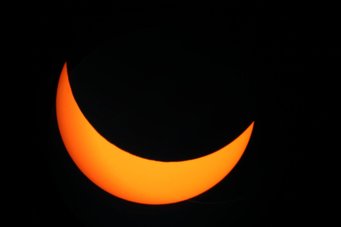Partial solar eclipse over Germany
In the morning of March 20th it was possible to view this impressive natural phenomenon using special eye protection
On March 20th a cosmic game of shadows took place in the skies over Central Europe: in the late morning, the new moon slid over the sun and obscured it by up to 80 per cent. Daylight became noticeably paler. In Germany, the next partial eclipse of this scale will not take place for another eleven years. What causes this natural phenomenon? And what are the safest ways to view it?

The sky darkened on Friday. At around 9:30 AM, the new moon partially obsured the eastern rim of the sun’s disk. And thus began a game of shadows, the likes of which we will not be seeing again in our corner of the world until 12 August 2026. This time we were not treated to a total eclipse, but as the partial phase culminated, the moon still covered up to 80 per cent of the sun.
General rule of thumb: the further north you are, the greater the degree of totality. While this equates to just about 68 per cent in Munich, observers elsewhere in the country witnessed the sun being obscured by a good 75 per cent in Berlin, 79 in Hamburg and more than 80 per cent in Kiel. Even the time of day at which the eclipse was visible fluctuated: here in Germany, the partial eclipse began between 9:26 AM (Freiburg in the far south of the country) and 9:41 AM (Stralsund in the far north). The maximum was reached in both of these locations between 10:34 and 10:49 AM, and the spectacle ended between 11:46 AM and 12 noon respectively.
The sun was already high in the sky by the time the eclipse occured. Even if the skies had been clouded over, daylight would have become dimmer as the eclipse reached its maximum. The clear skies we experienced over Germany were ideal for viewing the cosmic spectacle. You could even see it with the naked eye – but only with the right protection! Staring into the extremely bright disk of the sun without taking the necessary precautions can cause irreversible eye damage. Special “eclipse glasses” can be purchased over the Internet or from specialist retailers. If you already own a pair of eclipse glasses, inspect them to make sure that they are not damaged, scratched or punctured.
When viewing the eclipse without an optical instrument, you could see how the pitch-black disk of the new moon gradually “ate away” at the sun. If you were fortunate enough to use a telescope with suitable magnification, you would have noticed that the edge of the moon was not completely smooth: here and there, the lunar landscape was revealed in the form of tiny jagged edges or indentations.
It is also possible that the moon occasionally covers one or more sunspots as it travels across our daystar. When contrasted with the inner zone of a sunspot (umbra) and especially with the brighter aureole (penumbra) surrounding the latter, the moon appears even blacker.
If you viewed the eclipse using an optical instrument, you needed to make sure you only used materials that have been approved by the manufacturer. The best option was to use foils or filters that prevent light from entering the instrument in the first place; accessories known as ocular filters, on the other hand, might crack due to the intense heat and are therefore not advisable. The safest viewing method was to project the image of the sun onto a white screen, where it can be viewed without any risk by many people at once.
On March 20th the sun, the new moon and Earth were all lined up. Due to the fact that the moon’s orbit is tilted at five degrees to the plane on which Earth orbits the sun, this type of constellation is relatively rare. Only when the moon is located close to one of the two “nodes” (the points at which the two orbits intersect) does its shadow reach our planet.
At 10:14 AM on March 20th, the tip of the umbral cone touched down on Earth’s surface in the North Atlantic, south of Greenland. That is where a total solar eclipse began. The umbral shadow then raced across the open sea in a north-easterly direction at several times the speed of sound. Its path moved between the British Isles and Iceland and across the Faeroe Islands towards Spitsbergen before ending in the Artic, just 70 kilometres shy of the North Pole. The eclipse’s totality lasted a maximum of 2 minutes and 47 seconds.
Due to the fact that the umbra’s trajectory mostly passed across open waters or uninhabited areas, only a small number of people were able to view the total phase. The Slooh Community Observatory on the Faeroe Islands broadcast the eclipse over the Internet via live streaming. The European Space Agency (ESA) also followed the spectacle closely: the mini-satellite Proba‑2, which orbits 820 kilometres above the, observed the sun, while other satellites from the Proba family tracked the moon’s shadow as it travelled across the Earth’s surface.
HOR












